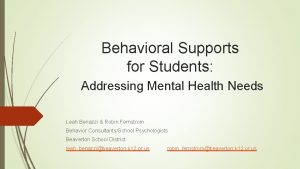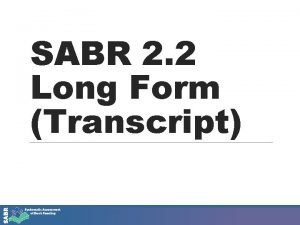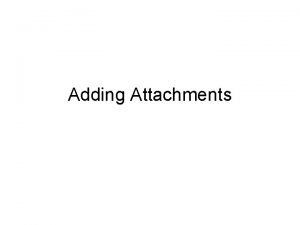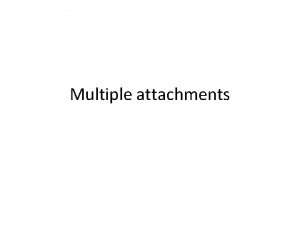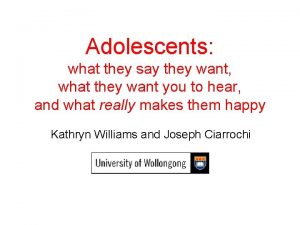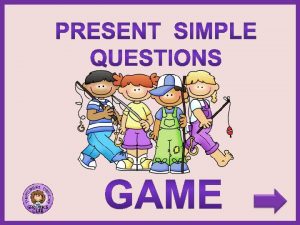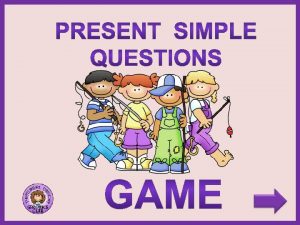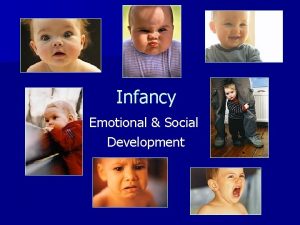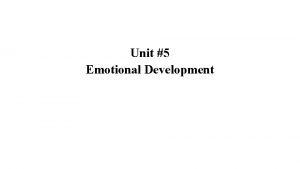ATTACHMENTS Attachments What are they An emotional tierelationship


































- Slides: 34

ATTACHMENTS

Attachments – What are they? • An emotional tie/relationship between two people shown by their behaviour • Between an infant and their caregiver (usually primary caregiver and infant) • Bond is reciprocal • Attachment usually develops in set stages over a specific time scale

eciprocity • Research in the 1970 s demonstrated that infants coordinated their actions with caregivers in a kind of conversation. From birth, babies move in a rhythm when interacting with an adult almost as if they were taking turns. • Trevathen suggested that turn taking in the infant- adult interaction is important for the development of social and language skills. R

eciprocity A demonstration of reciprocity R

Reciprocity • Smiling is an example of reciprocity – when a smile occurs in one person it triggers a smile in the other. • Tronick et al asked mothers who had been enjoying a dialogue with their baby to stop moving and maintain a static, unsmiling expression on their faces. • Babies would try to tempt the mother into interaction by smiling themselves, and would become puzzled and increasingly distressed when their smile did not provoke the usual response. • Occasional disconnections in reciprocity are thought to be beneficial for an infant’s development. However, continual disconnections can have long-term effects on an infant’s social, intellectual development https: //www. youtube. com/watch? v=b. G 89 Qxw 30 BM https: //www. youtube. com/watch? v=vm. E 3 Nf. B_Hh. E

Naturalistic Observations - Starter • On your own, complete the match up activity on your desk.

NATURALISTIC OBSERVATIONS

Different Types of Observations Naturalistic Observation Participant Observation Involves the observer becoming directly involved in the activities of the people being studied. Participants are aware that they are being observed (they have given their permission/consent to the observer). Non-Participant Observation The observation of behaviours in a natural setting. The researcher makes no attempt to influence the behaviour of those being observed. Disclosed Observation Participants are unaware that they are being observed (they have not given their permission prior to the observation). Undisclosed Observation Involves the researcher observing the behaviour from a distance; the observer does not become actively involved in the behaviour being studied.

Participant / Non Participant Disclosed / Undisclosed

Participant / Non Participant Disclosed / Undisclosed

Participant / Non Participant Disclosed / Undisclosed

Using Observations and Collecting Data • What methods could Psychologists use to collect data from an observation? • Qualitative methods (write down exactly what you see in as much detail as possible). • Quantitative methods (how could we collect quantitative data? ) • Behaviour Schedule.

Collecting Data – Over to You! • Aim: You are interested in looking at reciprocity in infants and what happens when infants experience the ‘blank face’ experiment. • In Groups: (1) Create a behaviour schedule which will aim to measure the behaviours demonstrated by infants during the blank face experiment.

Collecting Quantitative Data – Behaviour Schedules • A checklist of precisely defined behaviours • The behaviours within the checklist should attempt to cover all possible behaviours that may occur Behaviour Tally Total

Behaviour Schedule • Each category should be mutually exclusive – meaning that the observer should not have to mark 2 categories with one behaviour.

A Perfect Behaviour Schedule? Behaviour Shouting Screaming Kicking Punching Smacking Hitting Swearing Tally Total

Behaviour Schedule • Once the experimenter starts the observation they cannot add anymore behaviours to the schedule – why?

Designing Your Own Observation • In groups, think about a number of behaviours you might want to look at in order to investigate reciprocity and an infant’s reaction to the ‘blank face’ stage of the experiment. • Remember, the more specific your behaviours the more you will learn about children’s behaviour.

Time to Conduct Your Observation • https: //www. youtube. com/watch? v=b. G 89 Qxw 30 BM

Pilot Study • Any problems? • A pilot study can help determine what behaviours should go into the behaviour schedule. • A psychologist can observe a situation before they carry out the recorded observation in an attempt to decide what behaviours should go into the schedule.

Designing Your Own Observation • It is important that you write the same behaviours in your behaviour schedule as the people in your group. • This is necessary for assessing the reliability at the end of the observation.

Inter-Rater Reliability • A way of improving reliability of a naturalistic observation. • Data produced can be very subjective (open to interpretation) • Look at the consistency of the findings across the different observers.

Evaluating Naturalistic Observations Strengths ü Measuring real life, naturally occurring behaviour therefore the findings will have high ecological validity. ü Collecting data using event sampling (i. e. the behaviour schedule) means that the data can easily be quantified. ü Collecting data using continuous observation (i. e. collecting qualitative data) means that the observations recorded will be rich in detail. Weaknesses v The observer has in mind the behaviours that they are looking for and therefore, the data collection may be subject to observer bias. v In disclosed observations, participants are aware that they are being watched and so may act unnaturally – demand characteristics. v For participants who aren’t aware that they are being observed, the observation can be criticised as being unethical.

Naturalistic Observations - Plenary In your research methods glossary, define the following terms from today’s lesson. Naturalistic Observation Participant Observation Non-Participant Observation Disclosed Observation Undisclosed Observation Behaviour Schedule Inter-Rater Reliability

Interactional Synchrony • Psychologists have described a slightly different interaction between infants and caregivers called interactional synchrony which is when two mirror pattern people interact in a in terms of their facial and body movements. This includes imitating emotions as well as behaviours.

Research by Meltzoff & Moore Findings – The results indicated • Meltzoff & Moore (1977) observed the beginnings of that babiessynchrony between 12 to 27 as interactional in infants as young 1227 weeks old. imitate both facial days could • Babies exposed to 4 stimuli (three facial gestures and expressions one manual gesture)and manual gestures Aim – to investigate reciprocity and interactional synchrony between infants and the caregivers • Responses to these gestures were observed – actions were video recorded. • An independent observer was asked to note all the Conclusion – the ability to imitate serves a incidents of tongue protrusion and head movements purpose and is an important building block using a number of behavioural categories. for later social and development • Each observer scored the cognitive tapes twice (intra-observer reliability)

Evaluation of Research into Care-Giver and Infant Interactions • The controlled observations often capture fine details as they are generally well-controlled procedures For example, both the mother and the infant are filmed, often from multiple angles, this ensures that fine details of behaviour can be recorded and later analysed. Furthermore, babies are unaware that they are being observed so their behaviour does not change in response to controlled observations which is generally a problem for observational research. • This is positive because it means that in general the research has high internal validity – it is measuring what it intends to.

Evaluation of Research into Care-Giver and Infant Interactions • However, observations don’t tell us the purpose if synchrony and reciprocity. For example, Fieldman (2012) points out that synchrony (and by implication reciprocity) simply describe behaviours that occur at the same time. • This is a weakness because these are robust phenomena in the sense that they can be reliably observed, but this may not be particularly useful as it does not tell us their purpose.

Evaluation of Research into Care-Giver and Infant Interactions • It is hard to know what is happening when observing infants. For example, is the infant’s imitation of the adult conscious and deliberate or a coincidence? What is being observed is merely hand movements or changes in expressions. It is extremely difficult to be certain, based on these observations, what is taking place from the infant’s perspective. • This is a weakness because we cannot really know for certain that behaviours seen in mother-infant interactions have special meaning.

Differences between Reciprocity and Interactional Synchrony Reciprocity Two-way, mutual interaction Interactional Synchrony Interaction is rhythmic and can include the infant and caregiver mirroring each other’s behaviour and emotion Infant and caregiver are both active The infant and caregiver’s contributors in the interaction and behaviours and affect are responding to each other synchronised because they are moving in the same, or a similar, pattern. Tronick - Blank Face research, illustrates infants become destressed when parents fail to reciprocate social behaviour Meltzoff and Moore showed that children are synchronised with their caregiver as they imitate facial expressions and manual gestures.

Exam Questions 1. Explain what is meant by interactional synchrony (2 marks) 2. Explain what is meant by the term reciprocity in the context of caregiver-infant interactions (2 marks) 3. Outline research into caregiver-infant interactions. (4 marks) 4. Explain why reciprocity and interactional synchrony are important in the formation of attachments (4 marks)

Apply it! Proud father Abdul was talking to his friend, as they were both watching Abdul’s wife, Tasneem, interacting with their baby daughter, Aisha. “It’s amazing really” said Abdul. “Tasneem smiles, Aisha smiles back. Tasneem moves her head, Aisha moves hers, perfectly in time with each other” “Yes”, agreed the friend “Its almost as if they are one person”. With reference to Abdul’s conversation with his friend, outline two features of caregiver interaction (4 marks)

Differences between Reciprocity and Interactional Synchrony Reciprocity Interactional Synchrony

Different Types of Observations Naturalistic Observation Participant Observation Involves the observer becoming directly involved in the activities of the people being studied. Participants are aware that they are being observed (they have given their permission/consent to the observer). Non-Participant Observation The observation of behaviours in a natural setting. The researcher makes no attempt to influence the behaviour of those being observed. Disclosed Observation Participants are unaware that they are being observed (they have not given their permission prior to the observation). Undisclosed Observation Involves the researcher observing the behaviour from a distance; the observer does not become actively involved in the behaviour being studied.
 Insidan region jh
Insidan region jh Biceps brachii origin and insertion
Biceps brachii origin and insertion Anterior superior iliac spine
Anterior superior iliac spine M
M Biceps brachii
Biceps brachii Nerve to subclavius
Nerve to subclavius Rotator cuff interval
Rotator cuff interval Cascade pallet inverter
Cascade pallet inverter Obliques attachments
Obliques attachments Palmar interossei
Palmar interossei Inspiration muscles
Inspiration muscles Semi precision attachments
Semi precision attachments Fll passive attachments
Fll passive attachments Joint innervation
Joint innervation What nerve supplies serratus anterior
What nerve supplies serratus anterior Scm attachments
Scm attachments 1 complete the sentences
1 complete the sentences Grammar rules frustrate me they're not logical they are so
Grammar rules frustrate me they're not logical they are so They seek him here they seek him there
They seek him here they seek him there For they not know what they do
For they not know what they do I have not rejected you
I have not rejected you Although they knew god they did not glorify him
Although they knew god they did not glorify him Rankings: what are they and do they matter?
Rankings: what are they and do they matter? They are they which testify of me
They are they which testify of me Mental health skill building interventions examples
Mental health skill building interventions examples What's attachment parenting
What's attachment parenting Healthy emotional attachment
Healthy emotional attachment Joaquin phoenix your honor
Joaquin phoenix your honor Testimonial bandwagon
Testimonial bandwagon Evolution of emotional intelligence
Evolution of emotional intelligence Emotional interaction
Emotional interaction Emotional state examples
Emotional state examples Social emotional learning washington state
Social emotional learning washington state Blueeq emotional intelligence
Blueeq emotional intelligence Bpd quotes
Bpd quotes
























